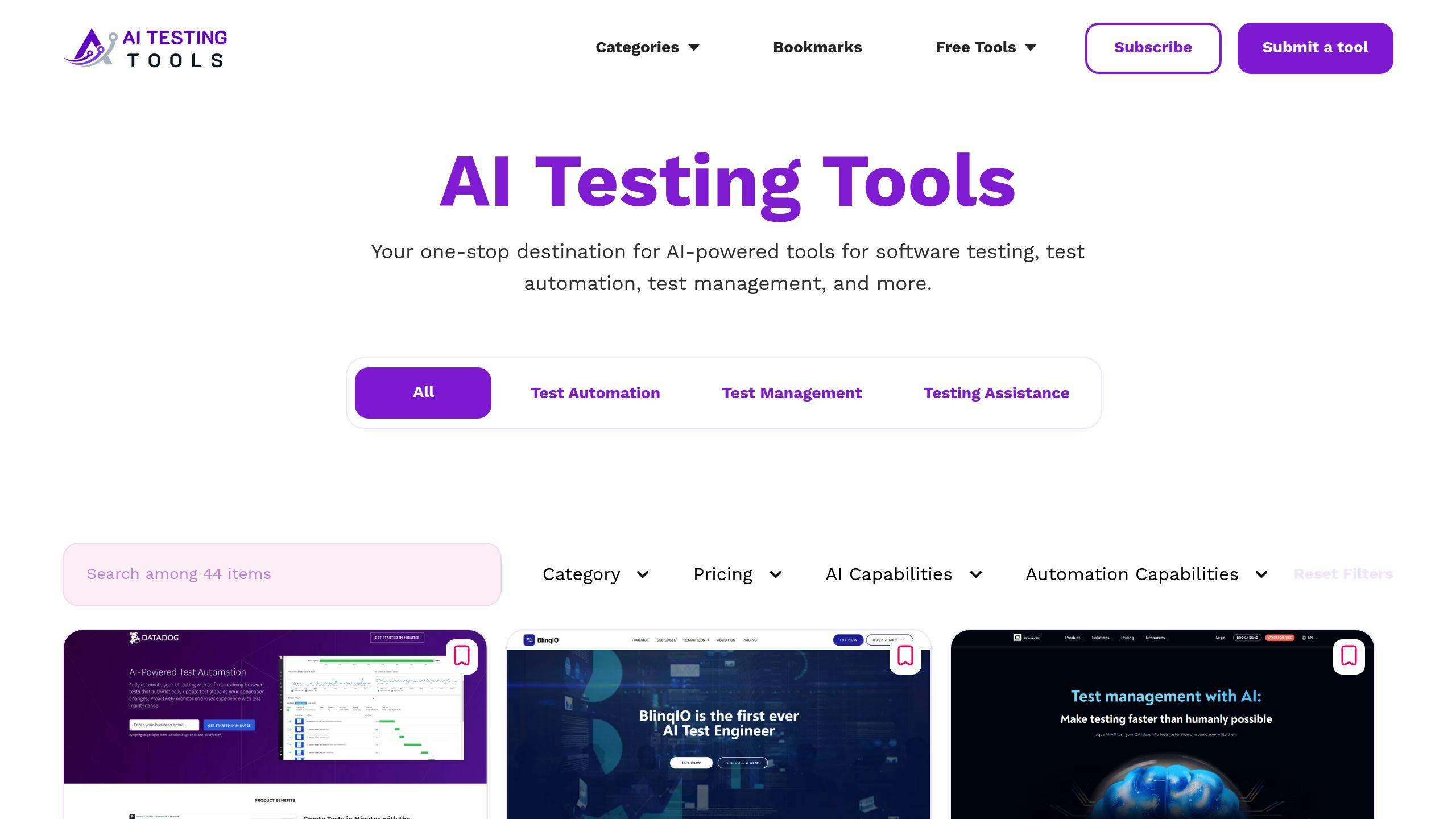AI test automation is transforming software testing by making it faster, more efficient, and easier to maintain. Here's what you need to know:
- What is AI Test Automation? It combines AI and machine learning to automate tasks like test creation, self-healing maintenance, and defect detection.
- Why Use AI in Testing? Benefits include 90% less test maintenance, 50% faster cycles, and broader test coverage.
- Advantages: Expanded test coverage, reduced maintenance with self-healing tests, and improved accuracy.
- Top Tools: Tools like Katalon, Testim, and Applitools offer features like self-healing scripts, visual validation, and NLP-based test creation.
- Future Trends: Autonomous testing, predictive analytics, and natural language processing are shaping the future.
Quick Tip: Start small with pilot projects, choose tools that fit your needs, and train your team for AI-driven testing. AI isn’t replacing testers - it’s enhancing their capabilities.
How to Use Selenium with AI
Advantages of AI in Test Automation
AI-powered test automation brings measurable gains in both efficiency and quality. Here's how organizations are benefiting:
Expanded Test Coverage and Improved Efficiency
AI enhances testing by automating tasks like test generation, parallel execution, case prioritization, and identifying edge cases. These advancements go beyond basic automation, offering real performance boosts:
- Run tests simultaneously across various environments
- Focus on critical test cases based on recent code updates
- Spot and test edge cases that might escape human attention
For example, Spotify adopted AI testing tools and saw a 50% cut in test execution time while expanding test coverage by 30% [4].
Reduced Maintenance with Self-Healing Tests
Self-healing tests are changing the game for test maintenance. According to Testim, companies can reduce test maintenance time by up to 70% with this feature [5]. Here's how it works:
- Automatically updates test scripts to match application changes
- Recommends script updates when app modifications are detected
- Handles unexpected errors during test runs without manual intervention
"Self-healing test automation has transformed how we maintain our test suite. What used to take hours of manual updates now happens automatically, allowing our team to focus on creating new test scenarios rather than fixing existing ones." - Lisa Crispin, Software Testing Expert and Author, TestCraft Blog, 2024
Enhanced Accuracy and Reliability
AI ensures more accurate and reliable testing through consistent execution and advanced analysis. A Sauce Labs study highlights the following improvements:
| Improvement Area | Impact |
|---|---|
| Defect Detection | 20% increase |
| Overall Software Quality | 15% improvement |
| False Positive Reduction | 35% decrease |
Building on Spotify's success, American Express leveraged AI for pixel-perfect visual validation and error-free execution. The result? A 60% reduction in testing time and a 35% boost in defect detection [6]. As testing technology advances, these benefits are likely to grow even further.
Leading AI-Powered Testing Tools
AI testing tools have come a long way, offering advanced solutions to tackle modern testing challenges. These tools are designed to streamline processes, reduce errors, and save time, making them a game-changer for QA teams.
AI Testing Tools Directory

This directory is a go-to resource for comparing AI testing tools. It includes detailed filters for testing types, up-to-date feature comparisons, and verified user reviews to help you make informed decisions.
Comparison of Top AI Testing Tools
Here's how some of the top AI testing tools stack up:
| Tool | Core AI Capability | Impact |
|---|---|---|
| Katalon | Self-healing scripts | Cuts maintenance costs by 50% |
| Testim | NLP test creation | Reduces flakiness by 80% |
| Applitools | Visual AI validation | Achieves 99.9% accuracy |
| Functionize | Smart element detection | Lowers failure rates by 70% |
| Mabl | Auto-healing tests | Boosts reliability by 90% |
These tools are already making a difference. For example, Salesforce saw a 75% drop in test maintenance and tripled their coverage, while PayPal was able to cut test creation time by 70% thanks to AI.
"The implementation of AI-powered testing tools transformed our QA process. What previously took weeks now takes days, and our test coverage has never been more comprehensive."
When choosing the right tool, keep these factors in mind:
- Integration: Does it work with your current CI/CD pipelines?
- Testing Needs: Does it support web, mobile, or API testing?
- Pricing: Is the cost aligned with your budget and usage?
- Automation Features: How advanced are its AI and self-healing capabilities?
- Support: Is the technical support and documentation reliable?
These considerations can help you select a tool that fits your unique requirements and maximizes efficiency.
sbb-itb-cbd254e
Steps for Implementing AI Test Automation
Once you've explored the benefits and tools available, it's time to focus on how to put AI test automation into action. A structured approach can help organizations improve test coverage and boost efficiency.
Steps to Integrate AI into Test Workflows
Building on tool selection criteria, implementing AI in testing generally involves three main phases:
| Phase | Activities and Outcomes |
|---|---|
| Assessment | Review current testing processes, pinpoint automation opportunities, and set baseline metrics. |
| Implementation | Choose tools, run proof-of-concepts (POCs), and start with high-priority testing areas. |
| Scale | Broaden test coverage, fine-tune workflows, and measure progress over time. |
Tips for Successful Adoption
Start Small and Build Expertise: Focus on specific test scenarios to begin with, while equipping your team through training and hands-on practice.
Track Progress and Adapt: Define baseline metrics upfront. Regularly monitor results and tweak your approach based on what works and what doesn’t.
Addressing Common Challenges
Tool Integration: Work closely with vendors to ensure tools fit seamlessly into your existing systems and workflows.
Overcoming Resistance:
"The key to overcoming resistance to AI adoption in testing is to demonstrate early wins and involve testers in the process of defining how AI will augment their work, not replace it." - Lisa Crispin at TestCon Europe 2023
Managing Technical and Data Issues: Make sure your data validation processes are solid, and focus on ROI-driven implementations to control costs.
Future Trends in AI Test Automation
As organizations adopt current AI testing tools, new technologies are reshaping what's possible. AI test automation is advancing quickly, pushing testing capabilities far beyond today's standards.
New Technologies in AI Testing
Autonomous testing is changing the game. Modern AI systems are moving toward designing, running, and analyzing tests with little to no human input.
Here are some key advancements:
| Technology | Current Impact | Future Potential |
|---|---|---|
| Autonomous Testing | Cuts testing time by 45% | Enables nearly full automation with minimal human involvement |
| Visual AI | Speeds up UI testing by 90% | Delivers cross-platform visual checks without manual effort |
| Predictive Analytics | Expands test coverage by 37% | Predicts and prevents issues in real time |
| Natural Language Processing | Reduces test maintenance by 80% | Allows tests to be written and updated in plain English |
These technologies build on earlier advancements like self-healing and visual testing, taking them to the next level.
"AI is not just enhancing test automation; it's redefining the entire approach to software quality assurance. In the next five years, we'll see AI taking on more cognitive tasks in testing, allowing human testers to focus on strategic decision-making and creative problem-solving." - Dr. Jason Arbon, CEO of test.ai, AI Testing Summit 2024
Preparing for the Future of AI-Driven Testing
To stay ahead, organizations must plan strategically. The Capgemini World Quality Report 2023-2024 highlights that 86% of companies now view AI as essential for test automation. This underscores the need to prepare for what's coming.
Here’s how companies can get ready:
- Data Strategy Implementation: Build strong data collection and validation processes. Quality data is the backbone of any effective AI testing system.
- Skills Development: Train teams to blend traditional testing skills with AI and machine learning expertise.
- Infrastructure Readiness: Upgrade technical systems to support advanced AI-driven testing tools.
- Ethical Considerations: Create clear policies for responsible AI use in testing, addressing ethical concerns alongside technical and adoption challenges.
While some of these technologies are still in early stages, they promise to unlock new testing methods in the years ahead.
Conclusion: Key Takeaways
Summary of Key Points
AI-driven test automation has shifted from being a new concept to becoming a core part of modern software testing strategies. According to Capgemini, companies using AI for testing report 80% faster test creation and achieve 45% broader coverage.
Tools like Testim, Functionize, and Applitools have shown how AI can improve testing by increasing efficiency, boosting accuracy, and expanding coverage. Features like self-healing capabilities also help reduce maintenance efforts, making these tools a practical choice for many teams.
These advancements lay the groundwork for newer trends like autonomous testing and predictive analytics, which were covered earlier.
Next Steps for Action
To get started with AI in testing:
- Assess your current testing workflows and identify gaps or needs.
- Launch small pilot projects to test AI tools in a controlled environment.
- Invest in training your team to work with AI testing tools and approaches.
- Gradually scale successful initiatives across other projects.
Pay attention to data quality, ensure your infrastructure can support AI tools, and prioritize continuous learning to make the most of AI-powered testing.
As AI test automation continues to evolve, advancements like autonomous testing and predictive analytics are redefining the field. By starting the journey today, organizations can prepare to take full advantage of these developments in the future.
FAQs
How to integrate AI with test automation?
To successfully combine AI with test automation, you need a step-by-step plan that emphasizes gradual implementation and continuous improvement. AI-based testing tools analyze your application's structure, gather data, and generate templates as tests are executed. This process creates a detailed dataset, making it easier to spot issues with precision.
Here’s a practical framework to guide integration:
| Phase | Key Actions | Outcome |
|---|---|---|
| Assessment | Review current testing processes | Clear plan for integration |
| Tool Selection | Choose tools suited to your setup | Ensures compatibility |
| Pilot Implementation | Test on a specific module | Proof of concept |
| Scale-Up | Expand successful pilots | Greater test coverage |
"AI in test automation is not about replacing human testers, but augmenting their capabilities to achieve higher quality and efficiency." - Jason Arbon, CEO of test.ai
To make the most of AI in testing, focus on these two areas:
- Team Training: Equip your team with knowledge about AI tools and concepts.
- Data and Monitoring: Use high-quality test data and keep a close eye on AI performance.



